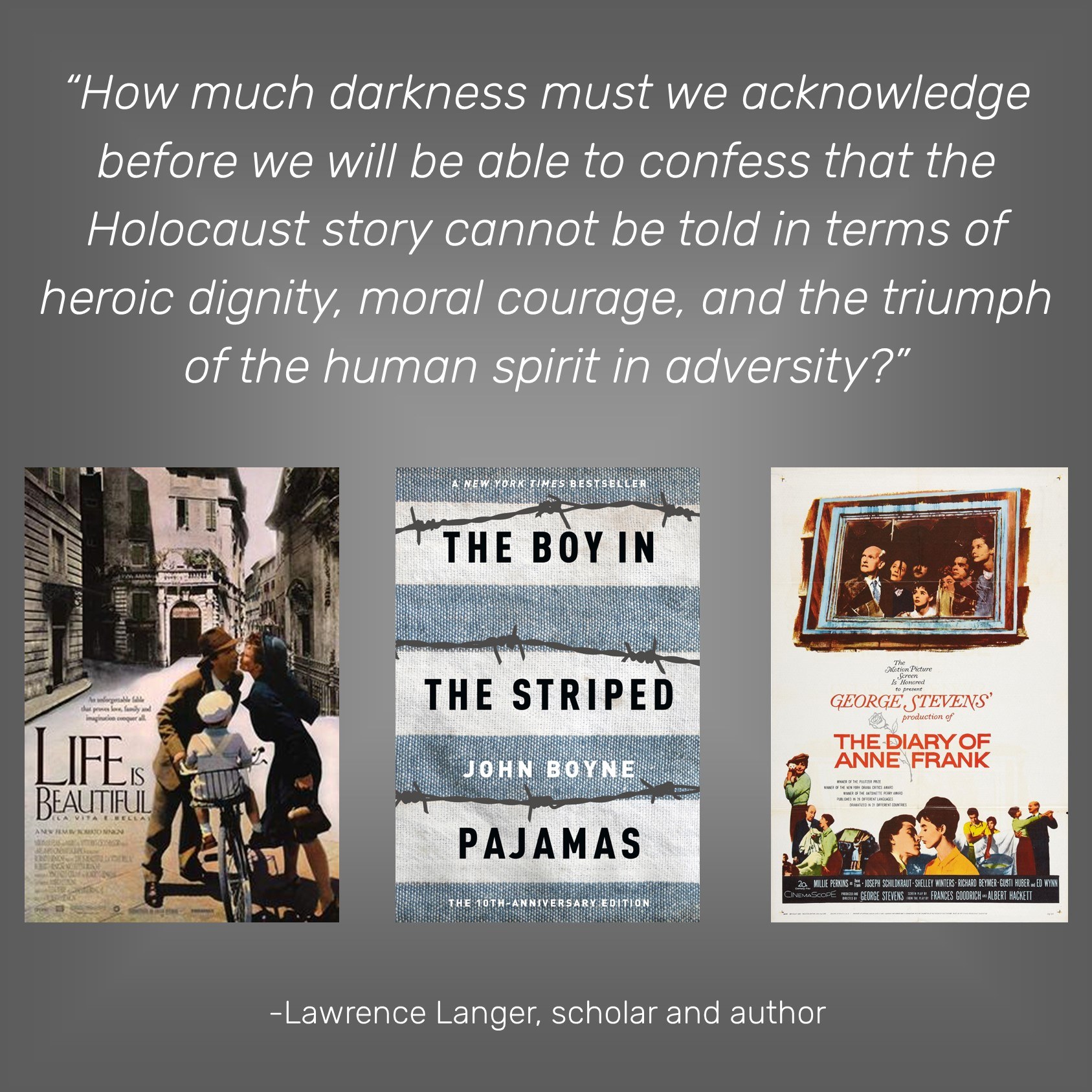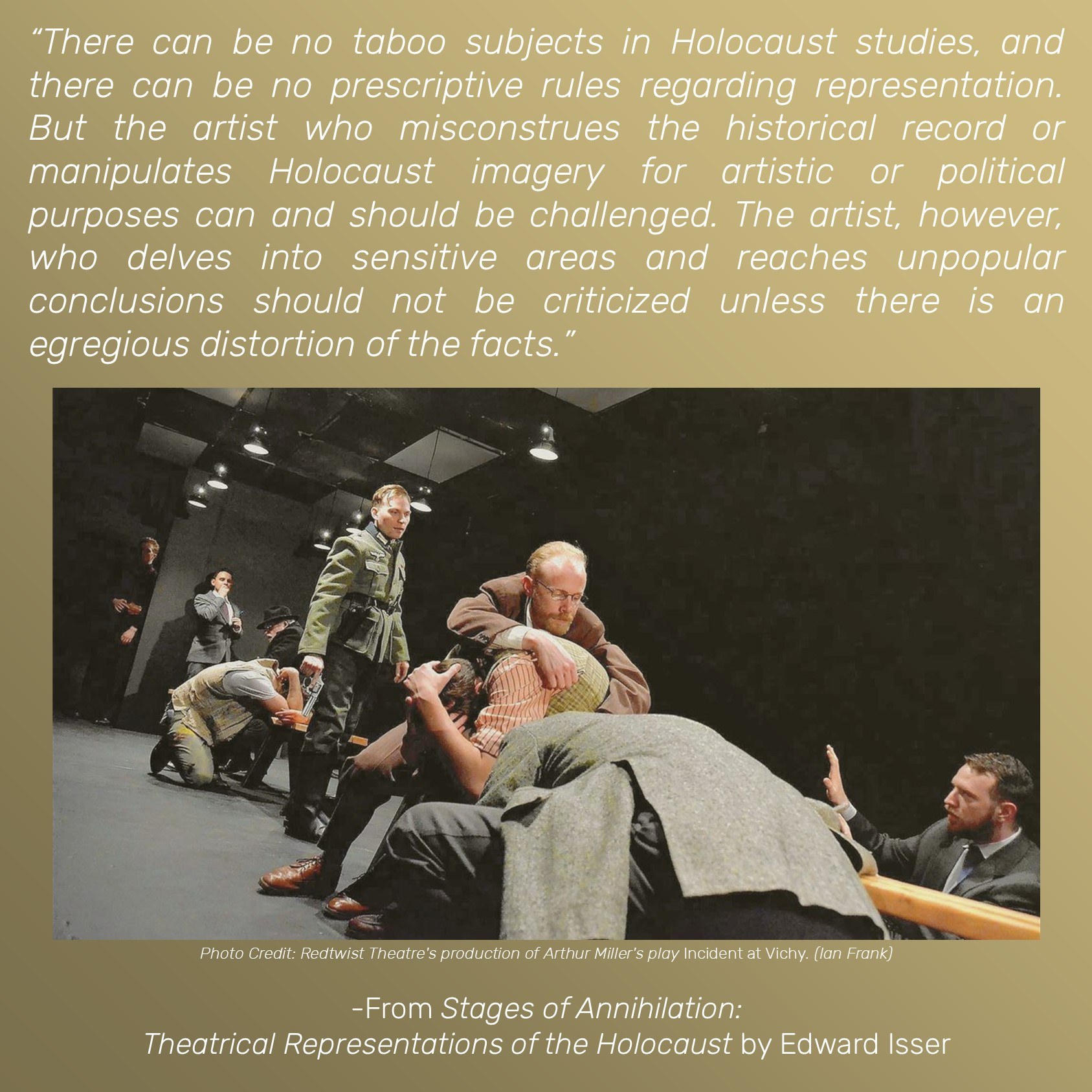Best Practices:
It is common for educators to be overwhelmed at the prospect of teaching young people about the Holocaust. The THGAAC is committed to offering workshops and other programs that build educators’ pedagogical and content mastery. The Commission also stresses adherence to methodological guidelines and curriculum standards, which help to establish a necessary framework for approaching the subjects in the classroom. By maintaining this framework, educators will be well poised to avoid the dangers of Holocaust distortions and denial.
All Schools: SB 1828 calls on the Texas Holocaust, Genocide, and Antisemitism Advisory Commission to develop or approve all materials that will be used in Texas classrooms during Holocaust Remembrance Week. The THGAAC's Holocaust Remembrance Week page provides educators with an assortment of options regarding materials to use. Please contact the THGAAC's office for any necessary clarification, suggestions, or guidance.
Effective instruction on the Holocaust must provide historical context, which necessarily involves the study of antisemitism. Educators are advised to visit the THGAAC's page on antisemitism; the page's content is approved for use during Holocaust Remembrance Week. However, students should be introduced to the themes of who the Jews are and what Judaism is before any Holocaust instruction occurs. Otherwise, students will be inclined to perceive Jews as natural and inevitable targets of persecution. (This might mean presenting a lesson on the Jews before teaching Holocaust history or Holocaust literature.)
Elementary Schools: SB 1828 calls for age-appropriate instruction, as determined by each school district. Please note that the THGAAC, like the United States Holocaust Memorial Museum, does not recommend explicit Holocaust instruction before 6th grade. Elementary schools are advised to choose their own materials that cover broader themes. These include:
- Community
- Tolerance (fighting prejudice)
- Responsible citizenship (being an upstander)
- Anti-bullying
- Who the Jews are. (This way, when Holocaust instruction occurs in the upper grades, it is not the students' first introduction to Jews or Judaism. This is key to making sure that students do not perceive Jewish identity solely through the lens of victimization.) Educators may note that many younger readers have enjoyed Sydney Taylor's All of a Kind Family series. Often compared to the writings of Louisa May Alcott and Laura Ingalls Wilder, these books do not depict the Holocaust or antisemitism, and instead provide a positive portrayal of a Jewish family in New York City during World War I.
Elementary school educators seeking more detailed materials, including lesson plans, can find them at the specific links from our museum partners:
- ELEMENTARY student resources are found in the Upstander Education Database and include the "I Am Human" Lesson (lower elementary), "I Am Anne Frank" Lesson (upper elementary), "Hidden Children-Secret Sanctuaries" Lesson (upper elementary), and elementary morning announcements.
- ELEMENTARY student resources can be found among the other HMH resources, but the museum's Young Upstanders Toolkit is specifically designed for this age group.
Middle Schools & High Schools: How educators approach the subject of the Holocaust is every bit as important as any lesson plans, readings, film viewings, or museum visits they put in their curriculum. In fact, oftentimes more egregious problems arise from methodology than from content. The THGAAC wishes to emphasize that a prudent starting point for building an understanding of appropriate pedagogy on the Holocaust is found in the United States Holocaust Memorial Museum (USHMM)’s Guidelines for Teaching About the Holocaust. The THGAAC strongly recommends that all educators familiarize themselves with these 10 guidelines before offering any instruction on the Holocaust; it is a good idea to revisit them before every Holocaust Remembrance Week. First among the guidelines is the necessity of clearly defining the Holocaust when engaging students.
Middle school and high school educators will find direction in the THGAAC Holocaust Remembrance Week Tip Sheet for Educators.
The following subjects may also be explored during Remembrance Week:
- What the Holocaust was (including the definition; see below)
- How the Nazis singled out the Jews for total annihilation and spread the lie that the killing of every Jewish man, woman, and child was essential to the world's salvation
- How antisemitism is a danger that reflects a psychological and spiritual illness in a society
- How the Holocaust signifies a breakdown of ethics, such as the devaluation of human life, which was necessary so that even the most educated people would support or participate in the killing process
- How the Holocaust began in a society in which individuals and groups failed to protect the rights of minorities (Jews, Roma/Sinti, homosexuals, etc.) and democratic institutions (legislature, courts, free press, truthful instruction in schools, etc.)

Holocaust Definition:
The Holocaust was the systematic, bureaucratic, state-sponsored persecution and murder of six million Jews by the Nazi regime and its collaborators. (Source: United States Holocaust Memorial Museum)
Other Victims of the Nazis:
The Nazis also persecuted political opponents, Jehovah's Witnesses, men accused of homosexuality, Black people, people with disabilities, Roma, Poles, Soviet officials, and Soviet prisoners of war. (Source: United States Holocaust Memorial Museum)
In particular, the experiences of the Roma (Gypsies), who were also persecuted and murdered by the Nazis, are a valid extension of lessons on the Holocaust. Dr. Ian Hancock of the University of Texas helped popularize the term, Porajmos, to refer to the Nazi persecution and mass murder of the Roma. Doris Bergen’s War and Genocide: A Concise History of the Holocaust also includes several pages on the Roma. International Holocaust Remembrance Alliance (IHRA) released in October 2020 its working definition of antigypsyism.
Educators would do well to note that the most effective teaching materials will stay true to the historical record by distinguishing between the experiences of different victim groups. There are too many examples of educational resources that fail to acknowledge these distinctions. As Professor David Patterson of the University of Texas at Dallas writes in 2021, “I have reviewed school textbooks claiming that Hitler sent ‘undesirables’ to the six extermination camps or that in those camps the Nazis murdered ‘Poles, Gypsies, Slavs, and other people,’ ignoring the fact that all six were designed specifically for the extermination of the Jews. Yes, others were murdered, but the Nazis sent only Jews from the trains to the gas chambers. They set out to make Europe only Judenrein, not Polenrein, Zigeunernrein, Slavenrein, or any other –rein. Their project of annihilation was not about blaming the Jews for their misfortunes but rested upon centuries of religious, philosophical, and political Jew hatred—not centuries of hatred of Gypsies, Communists, homosexuals, or the handicapped. The hatred of ‘other groups’ was not a defining feature of National Socialism; rather, it was derived from their hatred of Jews.”
By clearly defining the Holocaust as a Jewish experience, educators are better positioned to avoid the problematic trend of de-Judaizing the Holocaust. Moreover, when educators also acknowledge the horrors of other genocides in their proper context, including those committed by the Nazis and their accomplices in the same era as the Holocaust, students can gain a more authentic appreciation of history, human rights, and the challenges of today’s world.
To learn more about the other groups that were targeted by the Nazis, go to Nazi Genocides: 1933-1945. To learn about other genocides in history, see below.
Other Genocides in History:
As a state commission, the Texas Holocaust, Genocide, and Antisemitism Advisory Commission supports education on the Armenian genocide, the Cambodian genocide, the Rwandan genocide, the Bosnian genocide, the Darfur genocide, and the Syrian/Iraqi genocide. Educators wishing to extend lessons to include these other genocides may look to resources on the THGAAC website: Genocide Page (including overviews), Guidelines for Teaching About Genocide, as well as materials from outside organizations and museums listed on the Approved Lesson Plans and Other Resources for the Classroom page. In particular, the online resources for the Dallas Holocaust and Human Rights Museum also feature a set of graphic novels based on 10 Stages of Genocide.
Educators should make sure to convey that, while some similarities exist, the Holocaust was not identical to other genocides, just as they are not identical to one another. However, part of what makes them relevant today is what they all have in common: important lessons regarding the sanctity of human life and our responsibility to protect it.
Choosing Appropriate Language:
Teaching and learning typically depend on communicating with words and images. This dependence is unavoidably fraught with problems when educators encourage students to appreciate the scope and depth of the Holocaust’s horrors. Western civilization’s relationships to language and imagery came under assault during the Holocaust. By design, the Nazis manipulated and abused language and imagery to implement the destruction of a people. In this context, learning about the Holocaust demands sensitivity to the power of conventional tools of communication. The call for sensitivity is not a matter of monitoring word choices for mere political correctness. Rather, it is about developing a more precise lexicon that might permit us to comprehend, convey, and resist what the Nazis set out to accomplish in their assault on life and culture.
The THGAAC highlights the following terms, not to say that they should be avoided in all lessons, but so that they may be used in their proper context. Review Red Flag Terms.

Additional Insights:
Please be aware that Holocaust education inevitably engages disturbing themes. Some of the recommended materials include written accounts or imagery that may not be suitable to all students. The THGAAC cautions that educators should closely review materials according to local community and district standards before electing to teach with them.
Readings and Talks on Best Practices:
05 December 2024
Why Holocaust Education Isn’t Enough to Combat Antisemitism Today
01 November 2023
Re-examining Holocaust Education After the Hamas Massacre
16 March 2023
The Holocaust shouldn’t be a catch-all metaphor for hate – but we can still learn from comparisons
07 April 2021
Holocaust Education: Lessons Learned, Lessons Missed
04 April 2021
Op-Ed: ‘Never forget’ commands us to remember Holocaust horrors, not just the bravery of survivor
01 April 2021
Why Don’t More New Yorkers Know What Happened in the Holocaust?
2019
Recommendations for Teaching and Learning about the Holocaust
1 May 2018
Teaching the Holocaust Using Sports
01 February 2017
‘Remember the 11 million’? Why an inflated victims tally irks Holocaust historians
26 March 2015
"Teaching the Holocaust Using Art"
Why Simulation Activities Should Not Be Used

